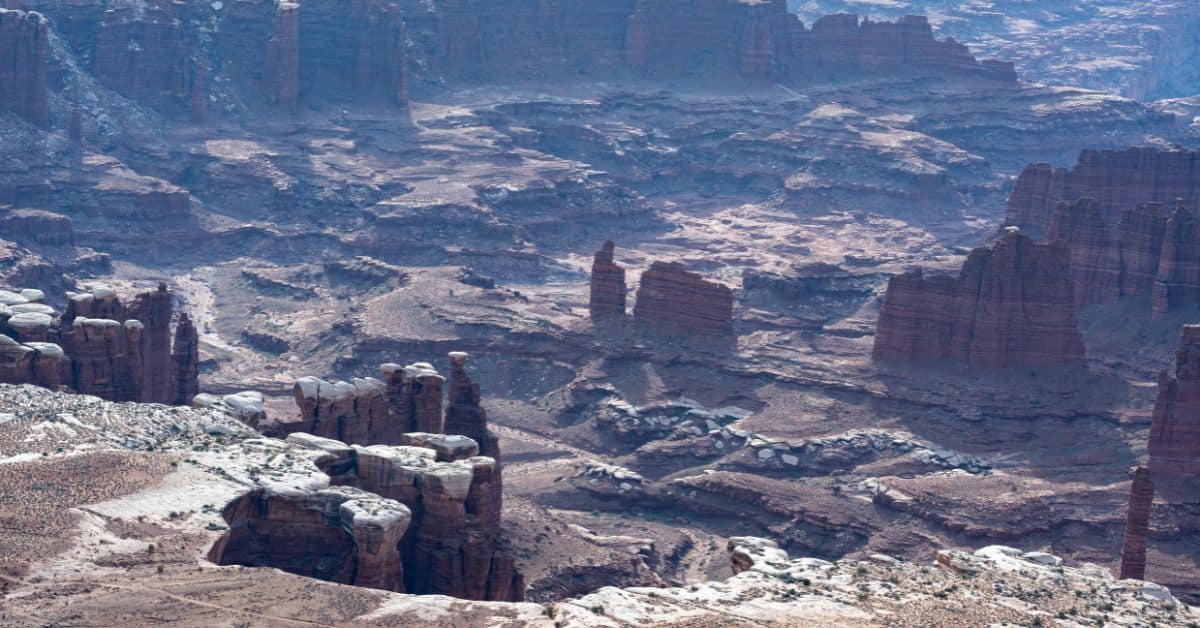Canyonlands Maze Guide: Is It For You? (Safety First)
If you’re considering the Maze District of Canyonlands National Park, this Canyonlands Maze guide is meant to help you decide whether you’re truly prepared—or whether you should stay somewhere less extreme.
This isn’t a casual day‑hike or scenic drive. This is remote country. If something goes wrong, help is far away. If your team lacks back‑country experience, self‑rescue ability, reliable communications, or a 4×4 vehicle, you may be in over your head.
For the right group the Maze can be spectacular—but only if you take self‑reliance seriously.
Table of Contents
Access & Permits
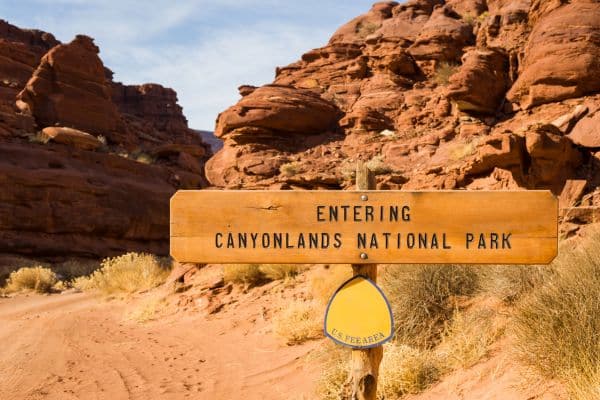
Permits
- Overnight backcountry permits are required for all non‑day use trips in the Maze.
- The official permit page states that all overnight trips and vehicle/back‑country camping require permit quotas.
- The permit reservation fee: $36 (includes $6 Recreation.gov fee) plus $5 per person per night.
- You’ll pick up maps and check in at the Hans Flat Ranger Station (open 8 a–3 p daily per NPS)
- For day‐use vehicle/back‑road trips, you must also comply with the high‑clearance 4WD vehicle requirement (see next section).
Road & Access Requirements
- The Maze roads are extremely remote and very difficult. The NPS states: “Four‑wheel‑drive roads in The Maze … extremely remote, very difficult, present considerable risk of vehicle damage, and should not be attempted by inexperienced drivers.”
- You must have a high‑clearance, low‑range 4×4 vehicle for the Maze roads.
- No ATVs/UTVs/OHVs permitted. Motorcycles must be highway‑legal.
- Road access examples: From UT‑24 to Hans Flat Ranger Station ≈ 46 miles of dirt road. Then from the ranger station into the Maze an additional 3–6 hours by high‑clearance four‑wheel‑drive.
- Road conditions can change rapidly (especially after storms). Always check the “Alerts & Conditions” page.
Self‑Reliance
Water & Navigation
- There are no potable water sources at Hans Flat or elsewhere in the Maze district.
- NPS advises backpackers: Plan to carry minimum 4 liters (≈1 gallon) of water per person per day, longer if temps exceed ~80 °F.
- Trails and routes are often unmarked. The hiking page cautions: “Routes into canyons may have cairns … but the washes are not marked. The canyons can look similar and be difficult to identify without a topographic map.”
- GPS units frequently lead people astray in the Maze. NPS explicitly warns this.
Hazards & Emergency Protocols
- If your vehicle breaks down you are in serious trouble. Towing costs can exceed $1,500.
- Phone service is unreliable or non‑existent. You should carry an EPIRB or satellite messenger (e.g., an inReach device) and know how to trigger rescue.
- Heat exposure and isolation: The desert environment coupled with remoteness means that small mistakes become large problems.
- Driving off road or in wet conditions is a frequent cause of being stuck. The “Flint Trail” section is often closed in winter due to clay slopes.
When Not to Go
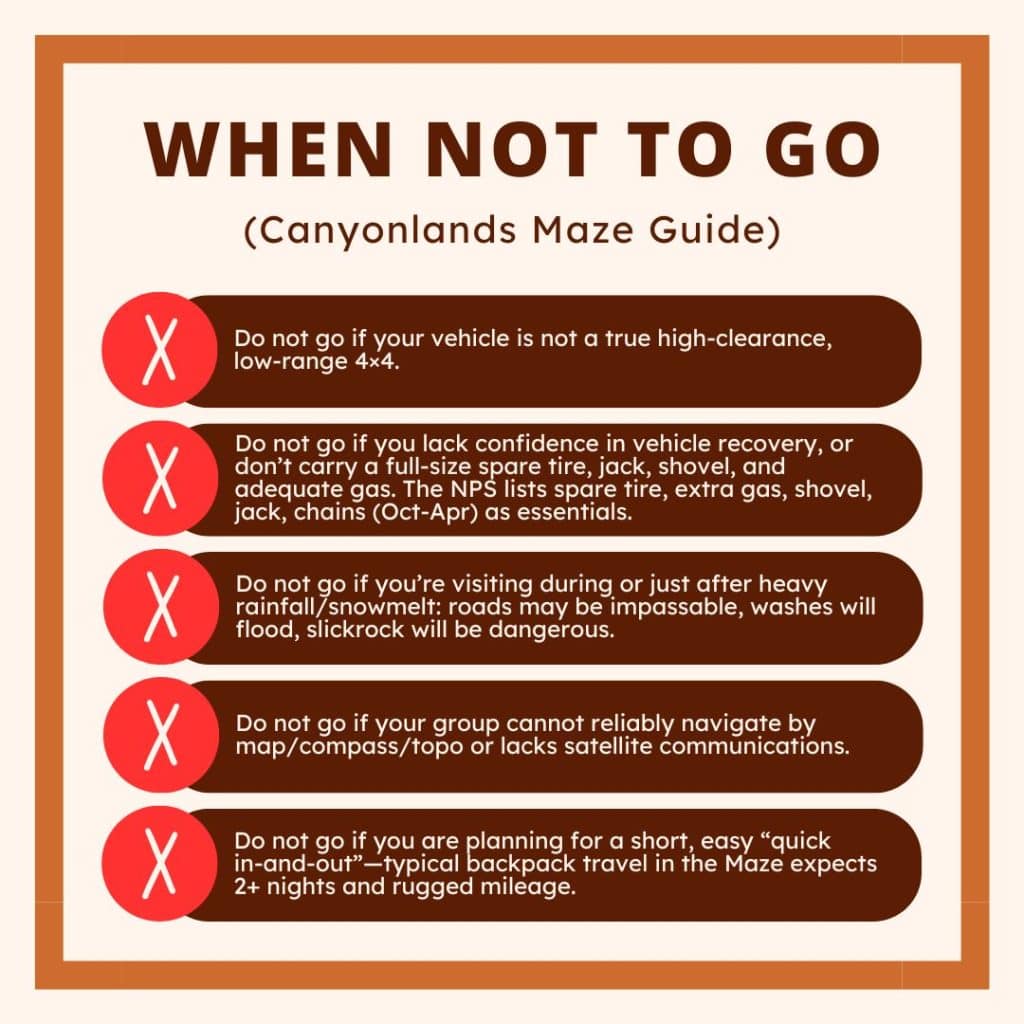
Getting There & Road Conditions
- From I‑70 (near Green River, UT) take UT‑24 south ~24 miles to the turnoff just beyond the Goblin Valley State Park turn.
- Then ~46 miles (≈76 km) of dirt road to the Hans Flat Ranger Station. Time: perhaps 2.5 hours in good conditions.
- From Hans Flat into the Maze back‑country can take 3 to 6 hours (or more) by high‑clearance 4×4.
- According to a third‑party report: “We drove out … the drive from the highway to the Maze Overlook will take anywhere between 3‑5 hours with the second half being on high clearance 4×4 short wheel base only.”
- Always check the NPS “Alerts & Conditions” page for recent closures or washouts. Verified as of 5 months ago.
Gear & Packing List
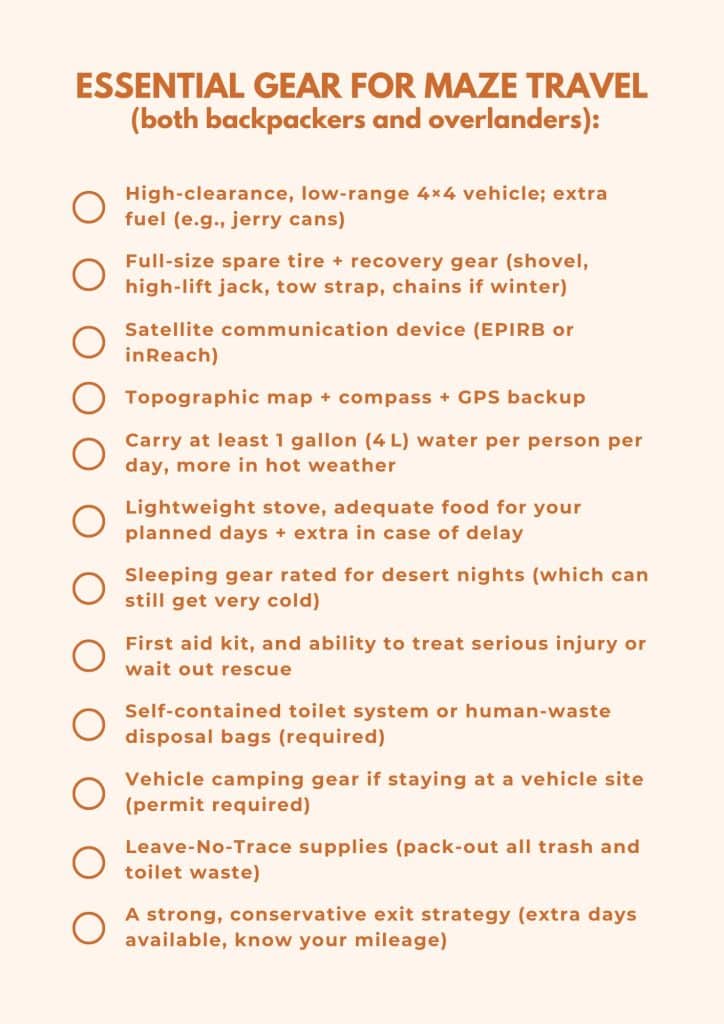
Minimal Impact & Rules
- Stay strictly on designated roads. Vehicles, bikes must remain on them.
- Camping only in designated sites (vehicle or backpack) with permit.
- No wood campfires in backcountry vehicle sites; you may cook with a firepan/charcoal if permitted.
- Do not camp within 300 feet of archaeological or historic sites or water sources.
- Pack out everything, including toilet paper, waste bags, food scraps.
Alternatives if the Maze Isn’t for You
If you read the above and feel under‑prepared, consider these lesser‑risky but still excellent options:
- Explore the Island in the Sky district of Canyonlands – more accessible roads, fewer extreme logistics.
- Go to the Needles District of Canyonlands – still wild, but better infrastructure and slightly less extreme approach.
- Day‑hike in the Maze Overlook area only (if you can drive to the overlook) instead of committing to deep canyon travel.
- Join a guided trip with an experienced outfitter in the Maze (less self‑rescue burden).
Decision Rubric
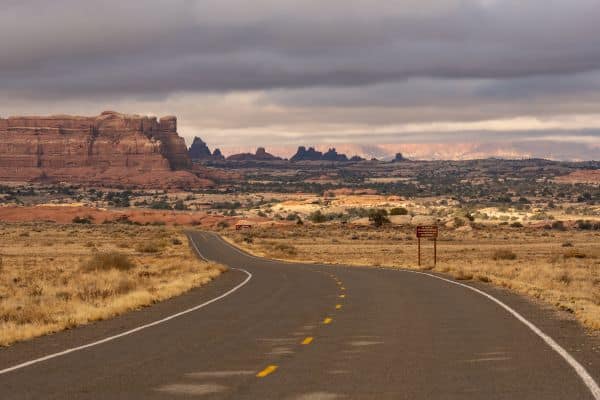
- If you are not fully confident in any one of the checklist items → Do not go into the Maze.
- If you are ready, experienced, and fully self‑sufficient → The Maze is for you, but respect the remoteness.
- If you want the Maze aesthetic but without extreme risk → Choose one of the alternatives above.
Canyonlands Maze Guide FAQs
Do I need a permit just to drive through the Maze District?
Yes. For vehicle/back‑road trips in the Maze you must have a backcountry vehicle permit if you are overnighting. If you are only driving day‑use, check the vehicle/road permit rules.
Can I use a standard 2WD vehicle?
No. The roads require a high‑clearance, low‑range 4×4. The NPS states that these roads are “very difficult… risk of vehicle damage.”
What if I get lost or injured deep in the Maze?
You are far from rescue. Cell coverage is not reliable. You need a satellite messenger/EPIRB and must be capable of self‑rescue, or wait for extended rescue.

